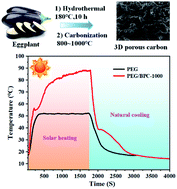当前位置:
X-MOL 学术
›
Sustain. Energy Fuels
›
论文详情
Our official English website, www.x-mol.net, welcomes your feedback! (Note: you will need to create a separate account there.)
Shape-stabilized phase-change materials supported by eggplant-derived porous carbon for efficient solar-to-thermal energy conversion and storage
Sustainable Energy & Fuels ( IF 5.6 ) Pub Date : 2020/01/06 , DOI: 10.1039/c9se01272a Yaqiong Li 1, 2, 3, 4, 5 , Xiubing Huang 1, 2, 3, 4, 5 , Yang Li 1, 2, 3, 4, 5 , Zuoshuai Xi 1, 2, 3, 4, 5 , Guangtong Hai 1, 2, 3, 4, 5 , Zhang Tao 1, 2, 3, 4, 5 , Ge Wang 1, 2, 3, 4, 5
Sustainable Energy & Fuels ( IF 5.6 ) Pub Date : 2020/01/06 , DOI: 10.1039/c9se01272a Yaqiong Li 1, 2, 3, 4, 5 , Xiubing Huang 1, 2, 3, 4, 5 , Yang Li 1, 2, 3, 4, 5 , Zuoshuai Xi 1, 2, 3, 4, 5 , Guangtong Hai 1, 2, 3, 4, 5 , Zhang Tao 1, 2, 3, 4, 5 , Ge Wang 1, 2, 3, 4, 5
Affiliation

|
In order to effectively solve the leakage problem and insufferably low thermal conductivity of organic phase-change materials (PCMs), three-dimensional (3D) spongy-like biological porous carbon (BPC) materials derived from eggplants were used as scaffolds for encapsulating polyethylene glycol (PEG) to fabricate shape-stabilized composite phase-change materials (ss-CPCMs). The relationship between the micro-morphology of the BPC and the heat-storage performance was assessed by controlling the post-pyrolysis temperature to regulate the micro-morphology of the carriers. It was found that the BPC consisting of nanopores and macropores with an average diameter of about 44.758 μm extended a high PEG loading (up to 90.1 wt%), while the hierarchical pores could prevent liquid leakage, enabling a melting enthalpy up to 149 J g−1. The ss-CPCMs also demonstrated excellent thermal cycling properties with a 96.3% retention after 50 cycles. In addition, the hierarchically porous structure of the BPC provides a good network channel for the thermal motion of phonons, which significantly improved the thermal conductivity. Moreover, as an effective photon captor and molecular heater, it could meaningfully improve the solar-to-thermal conversion efficiency of PCM composites. Therefore, the BPC with hierarchical scaffolds and excellent thermal conductivity derived from biomass provides promising applications in PCMs via a low-cost and easy preparation process.
中文翻译:

由茄子衍生的多孔碳支撑的形状稳定的相变材料,可有效地转换和存储太阳能
为了有效地解决有机相变材料(PCM)的泄漏问题和热导率极低的问题,将茄子衍生的三维(3D)海绵状生物多孔碳(BPC)材料用作封装聚乙二醇的支架(PEG)来制造形状稳定的复合相变材料(ss-CPCM)。通过控制热解后的温度来调节载体的微观形态,可以评估BPC的微观形态与储热性能之间的关系。发现由平均直径约为44.758μm的纳米孔和大孔组成的BPC扩展了较高的PEG负载量(高达90.1 wt%),而分层的孔可以防止液体泄漏,使熔化焓高达149 J g -1。ss-CPCMs还表现出出色的热循环性能,在50次循环后保留96.3%。此外,BPC的分层多孔结构为声子的热运动提供了良好的网络通道,从而显着提高了导热率。而且,作为一种有效的光子捕获器和分子加热器,它可以有意义地提高PCM复合材料的太阳热转换效率。因此,具有分层支架和源自生物质的出色导热性的BPC通过低成本且易于制备的过程在PCM中提供了有希望的应用。
更新日期:2020-03-31
中文翻译:

由茄子衍生的多孔碳支撑的形状稳定的相变材料,可有效地转换和存储太阳能
为了有效地解决有机相变材料(PCM)的泄漏问题和热导率极低的问题,将茄子衍生的三维(3D)海绵状生物多孔碳(BPC)材料用作封装聚乙二醇的支架(PEG)来制造形状稳定的复合相变材料(ss-CPCM)。通过控制热解后的温度来调节载体的微观形态,可以评估BPC的微观形态与储热性能之间的关系。发现由平均直径约为44.758μm的纳米孔和大孔组成的BPC扩展了较高的PEG负载量(高达90.1 wt%),而分层的孔可以防止液体泄漏,使熔化焓高达149 J g -1。ss-CPCMs还表现出出色的热循环性能,在50次循环后保留96.3%。此外,BPC的分层多孔结构为声子的热运动提供了良好的网络通道,从而显着提高了导热率。而且,作为一种有效的光子捕获器和分子加热器,它可以有意义地提高PCM复合材料的太阳热转换效率。因此,具有分层支架和源自生物质的出色导热性的BPC通过低成本且易于制备的过程在PCM中提供了有希望的应用。



























 京公网安备 11010802027423号
京公网安备 11010802027423号